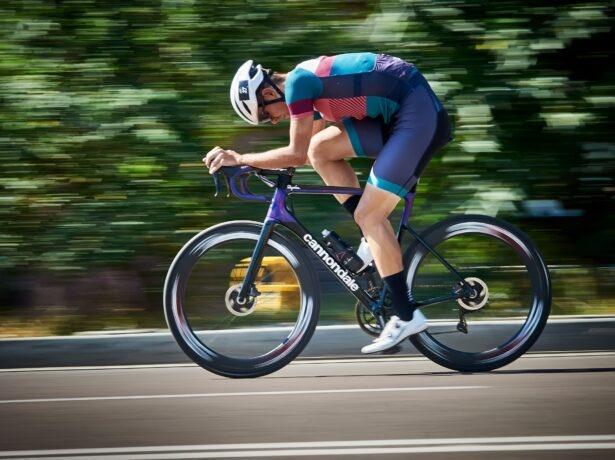A common question about road biking is, ‘are road bikes bad for your back?’. The answer is no, they shouldn’t be. But with the wrong set-up, cycling technique, or incorrectly sized road bike, it can take its toll on your back.
Do road bikes cause back pain?
If you already have a bad back, cycling has the potential for making it worse. The road bike style, with drop-down handlebars, naturally puts you into a more hunched, streamlined position, so while road bikes don’t cause back pain, they can aggravate someone who already has a back problem.
If you have the correct set-up and the right sized road bike, with no existing back pain, you shouldn’t experience any pain in your back. If you do, it’s normally an indicator of something set up incorrectly.
Are road bikes bad for posture?
 Given the cycling style, leaning over and gripping the handlebars, there is an assumption that road bikes can be bad for posture.
Given the cycling style, leaning over and gripping the handlebars, there is an assumption that road bikes can be bad for posture.
In all cycling cases, you are required to lean forward, which is different to almost all other sports and activities. The forward-leaning, added to the rotating leg action required to push the pedals, can stretch your lower back and impact your posture. However, this is normally not a problem for those who already have a reasonable base level of fitness.
A strong core also helps avoid back pain and any posture challenges. So, as mentioned above, if you already have bad posture or existing back problems, then cycling can aggravate it.
If road biking does cause pain, or stiffness for days after, you should take a break for a few days. Never overdo it or cycle through pain. Be mindful of how your back feels and adjust your cycling output accordingly.
How do you avoid back pain on a road bike?
To avoid back pain on a road bike, the key is in making sure you have the right road bike, which is correctly fitted and suits the way you cycle. Simply put, an ill-fitted road bike is the quickest way to get back pain, as well as risk longer-term health, more serious health conditions.
Here are some tips for avoiding back pain on a road bike:
Sizing: First things first, you need to be cycling on the right sized road bike. Road bikes are sized by measurement of the frame, which essentially means the bigger the frame, the further you’ll need to reach to touch the handlebars.
So the taller and bigger you are, the bigger frame you’ll need. There’s plenty of resources available to measure up your height to the right frame, but keep in mind that not all road bike manufacturers use the exact same frame measurements.
 If you get the sizing wrong, you’ll end up either over-reaching, which will put additional strain on your back, or hunched up, which will end up causing pain in your shoulders. An incorrectly sized road bike can also cause pain elsewhere, such as in your hips and knees.
If you get the sizing wrong, you’ll end up either over-reaching, which will put additional strain on your back, or hunched up, which will end up causing pain in your shoulders. An incorrectly sized road bike can also cause pain elsewhere, such as in your hips and knees.
If in doubt, the safest thing to do is get a professional to do a proper bike fitting, which will match your height and physique to a specific road bike.
Saddle: Secondly, setting up your saddle correctly plays a really important part in reducing back pain. Road bikes used to come as standard with a saddle that is set flat. That’s changed now and saddles are usually set in relation to your body shape.
Additionally, the way your saddle is set plays a massive part in where the strain of leaning over is on your back. A flatter saddle will result in lower back strain as you’ll be slightly more upright, whereas a saddle that is more significantly angled down will promote a more streamlined cycling position, but adds strain to your lower back.
Your saddle should never be facing upwards. If it is, you’ve got either the wrong saddle or the wrong sized road bike. Don’t be tempted to ride on it as you’ll end up damaging your body.
Most cyclists opt for a saddle that is slightly pointing downwards, which is the optimal riding angle for avoiding lower back pain. If the saddle is pointing too far down, however, you’ll increase the chance of back pain.
Your saddle must also be the right height for your comfort. You can base saddle height on where it comes up to your body when you stand next to the bike. A general rule is the saddle should be as high as your hip.
Handlebars: Your handlebars can be angled further down for a great racing profile, or upwards for greater comfort. Rotating the bars back a couple of degrees reduces the amount you have to lean over to ride, making it more comfortable. This will make you less streamlined but most road bikers aren’t using their road bike for racing.
The benefits of adjusting your handlebars is a more comfortable ride, which means great endurance and longer rides.
If your bike set-up is correct, then you’ll find the whole cycling experience more enjoyable. And, best of all, these tweaks are all free. If you feel discomfort, try tweaking the saddle or the handlebars again. As a last resort, get a full bike fit.
Conclusion
So, riding isn’t bad for your back if you’re fit and healthy, but can aggravate existing issues. If you’re experiencing back pain, try the small tweaks above and listen to your body when it is in pain.
Being mindful of back pain and making sure you’re cycling a properly set-up road bike are the two key components of avoiding back pain and enjoying the ride.

Founder of Vivi Nation, the cycling, running and active living brand. Chris is a sports enthusiast, occasional triathlete and experienced cyclist, having led multiple cycle tours across Europe.


